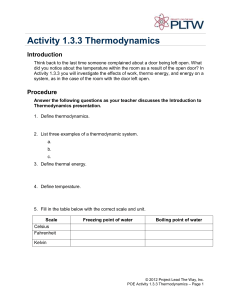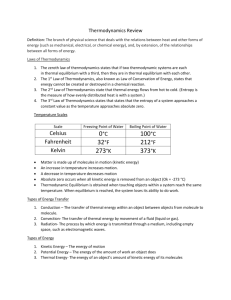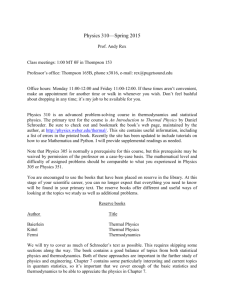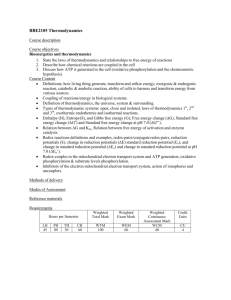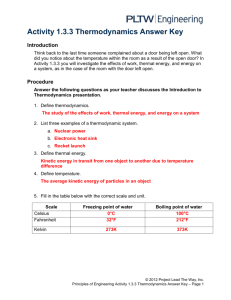Activity 1.3.3 Thermodynamics
advertisement
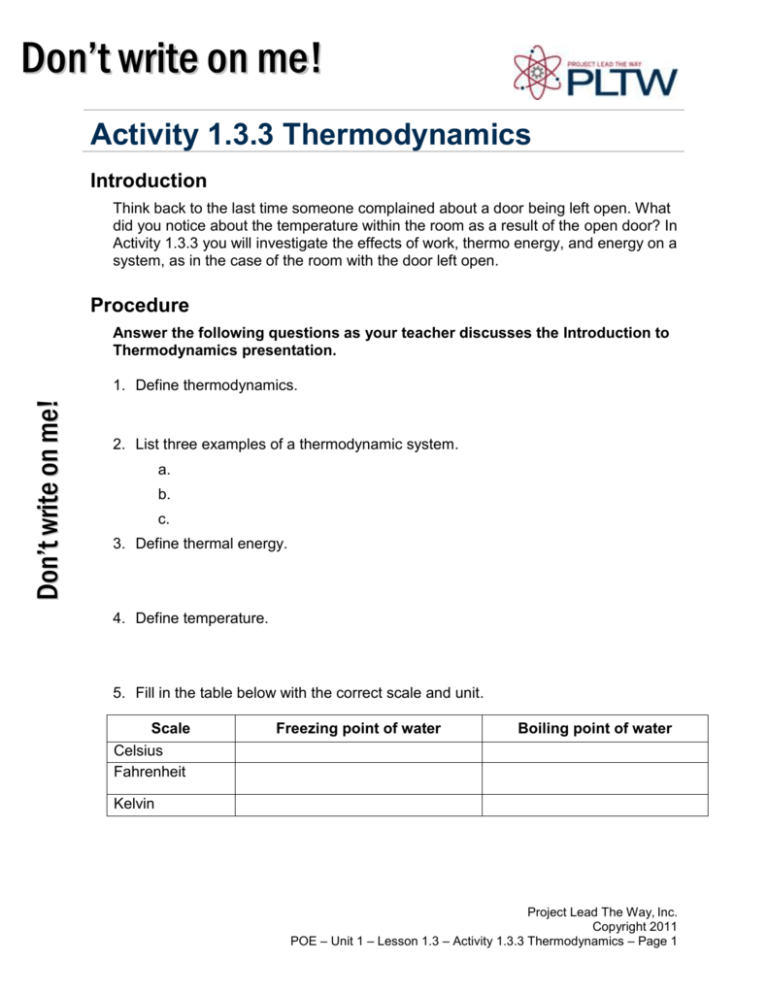
Don’t write on me! WRITActivity E ON M1.3.3 E! Thermodynamics Introduction Think back to the last time someone complained about a door being left open. What did you notice about the temperature within the room as a result of the open door? In Activity 1.3.3 you will investigate the effects of work, thermo energy, and energy on a system, as in the case of the room with the door left open. Procedure Answer the following questions as your teacher discusses the Introduction to Thermodynamics presentation. Don’t write on me! 1. Define thermodynamics. 2. List three examples of a thermodynamic system. a. b. c. 3. Define thermal energy. 4. Define temperature. 5. Fill in the table below with the correct scale and unit. Scale Celsius Fahrenheit Freezing point of water Boiling point of water Kelvin Project Lead The Way, Inc. Copyright 2011 POE – Unit 1 – Lesson 1.3 – Activity 1.3.3 Thermodynamics – Page 1 6. Define absolute zero. 7. Define thermal equilibrium. 8. Define the Zeroth Law of Thermodynamics. 9. Define the 1st Law of Thermodynamics. 10. List two ways thermal energy can be increased in a system. Don’t write on me! a. b. 11. Define the 2nd Law of Thermodynamics. 12. Define entropy. 13. Define convection. 14. List two examples of convection. a. b. 15. Define conduction. 16. List two examples of conduction. a. b. Project Lead The Way, Inc. Copyright 2011 POE – Unit 1 – Lesson 1.3 – Activity 1.3.3 Thermodynamics – Page 2 Conduction Equations: Q = m Cp ΔT ΔT P = kA L k= PL AΔT P= Q Δt 17. Define the following variables. Q= m= Cp = P= t= k= A= L= T= Δ= Project Lead The Way, Inc. Copyright 2011 POE – Unit 1 – Lesson 1.3 – Activity 1.3.3 Thermodynamics – Page 3 (18-22) A 1.00kg piece of aluminum metal at 90.0°C is placed in 4.00 liters (=4.00 kg) of water at 25.0°C. Determine the final temperature (Tf). 18. List all known values. 19. List all unknown values. Don’t write on me! 20. Select equations. 21. Apply known values. 22. Solve. Project Lead The Way, Inc. Copyright 2011 POE – Unit 1 – Lesson 1.3 – Activity 1.3.3 Thermodynamics – Page 4 (23-27) A 3/16 in. thick acrylic testing box with dimensions of 10.0 in. x 10.0 in. is covered with an unknown 0.50 in. insulation material. Determine the thermal conductivity for the insulating material if a 25.0W bulb is used to heat the box. The bulb maintains the inside temperature at 10.0ºC higher than the outside temperature. Don’t write on me! 23. List all known values. 24. List all unknown values. 25. Select equations. 26. Apply known values. 27. Solve. Project Lead The Way, Inc. Copyright 2011 POE – Unit 1 – Lesson 1.3 – Activity 1.3.3 Thermodynamics – Page 5 28. Define U-value. 29. Define R-value. Don’t write on me! (30-31) Use the provided R-value chart and the illustration below to calculate the Rvalue of the wall cavity and the R-value at the stud location. 30. Wall cavity R-value 31. R-value at stud location Project Lead The Way, Inc. Copyright 2011 POE – Unit 1 – Lesson 1.3 – Activity 1.3.3 Thermodynamics – Page 6 Don’t write on me! 32. Define radiation. 33. List two examples of radiation. a. b. 34. Define Stefan’s Law. (35-39) A student travels on a school bus in the middle of winter from home to school. The school bus temperature is 58.0° F. The student’s skin temperature is 91.4° F. Determine the net energy transfer from the student’s body during the 20.00 min ride to school due to electromagnetic radiation. Note: Skin emissivity is 0.90, and the surface area of the student is 1.50m2. 35. List all known values. 36. List all unknown values. 37. Select equations. Project Lead The Way, Inc. Copyright 2011 POE – Unit 1 – Lesson 1.3 – Activity 1.3.3 Thermodynamics – Page 7 38. Apply known values to equations. 39. Solve. 40. Define geothermal energy. Project Lead The Way, Inc. Copyright 2011 POE – Unit 1 – Lesson 1.3 – Activity 1.3.3 Thermodynamics – Page 8 R-Value Chart Construction Material ½ in. Drywall 5/8 in. Drywall Particle Board – ½ in. Particle Board – ¾ in. Fiberboard ½ in. Extruded Polystyrene 1 in. Extruded Polystyrene 1 ½ in. Foil-faced Polyisocyanurate 1 in. 2x4 2x6 Hardwood Masonry Systems Brick 4 in. common Brick 4 in. face Concrete Block – Normal wt. 12 in. empty core Concrete Block – Light wt. 12 in. empty core Cement Mortar Sand and Gravel Stucco Roofing Asphalt Roll Asphalt Shingle Slate Wood R-Value 0.45 0.56 0.63 0.94 1.32 4.00 6.00 7.20 4.38 6.88 0.90 R-Value 0.80 0.44 1.23 2.60 - 2.30 0.20 0.60 0.20 R-Value 0.15 0.44 0.05 0.94 Siding Wood Shingles Wood Drop Wood Bevel Lapped Aluminum/Steel – Hollow Aluminum/Steel – with 3/8 in. Backer Insulation Fiberglass Batt Blankets – Rock Wool Loose Fill – Cellulose Loose Fill – Fiberglass 0.7 lb/cu.ft Loose Fill – Rock Wool Loose Fill – Vermiculite Extruded Polystyrene R-Value 0.87 0.79 0.80 0.61 1.82 R-Value per in. 3.142 3.0 - 3.8 2.8 - 3.7 2.2 - 4.0 3.1 2.2 4.00 Project Lead The Way, Inc. Copyright 2011 POE – Unit 1 – Lesson 1.3 – Activity 1.3.3 Thermodynamics – Page 9
